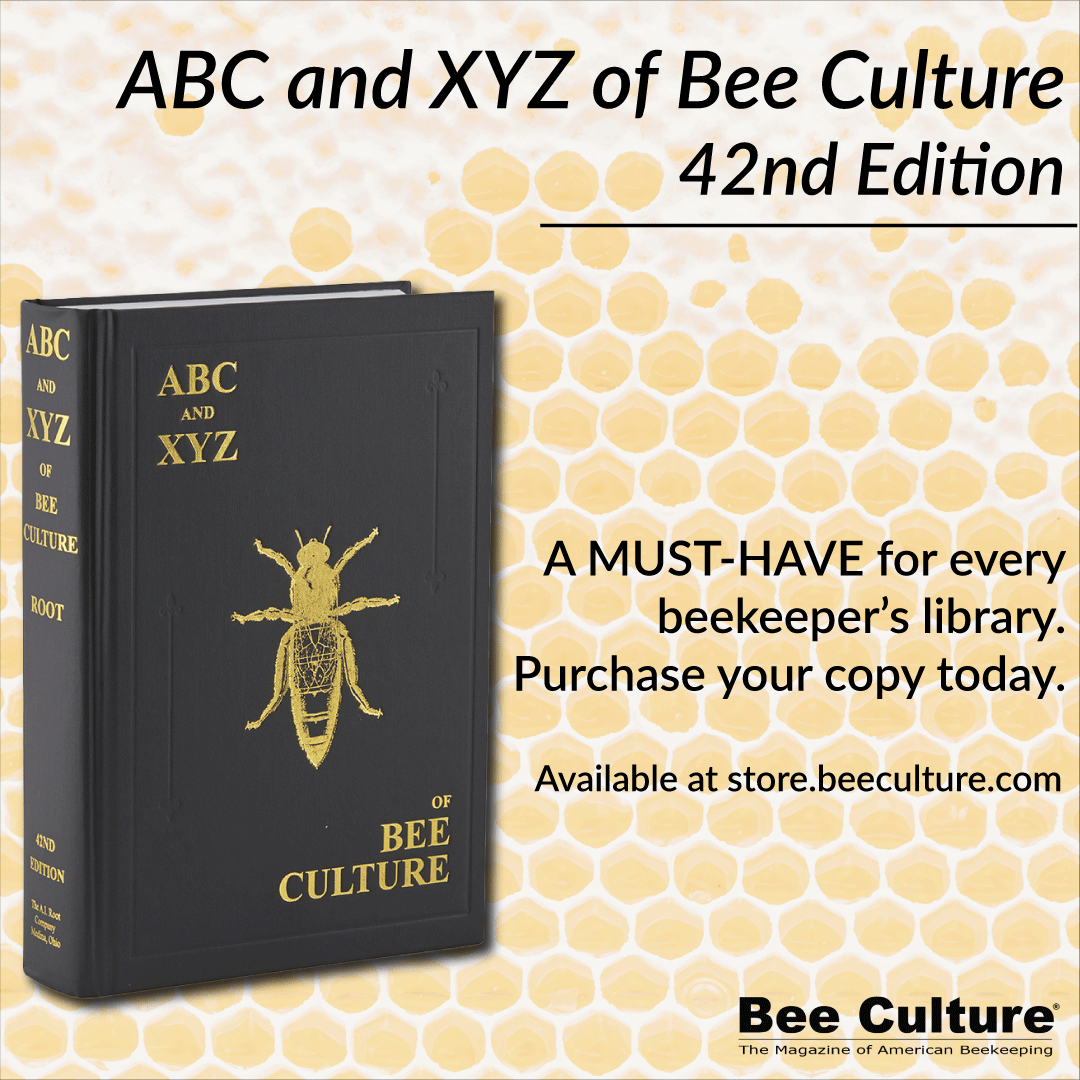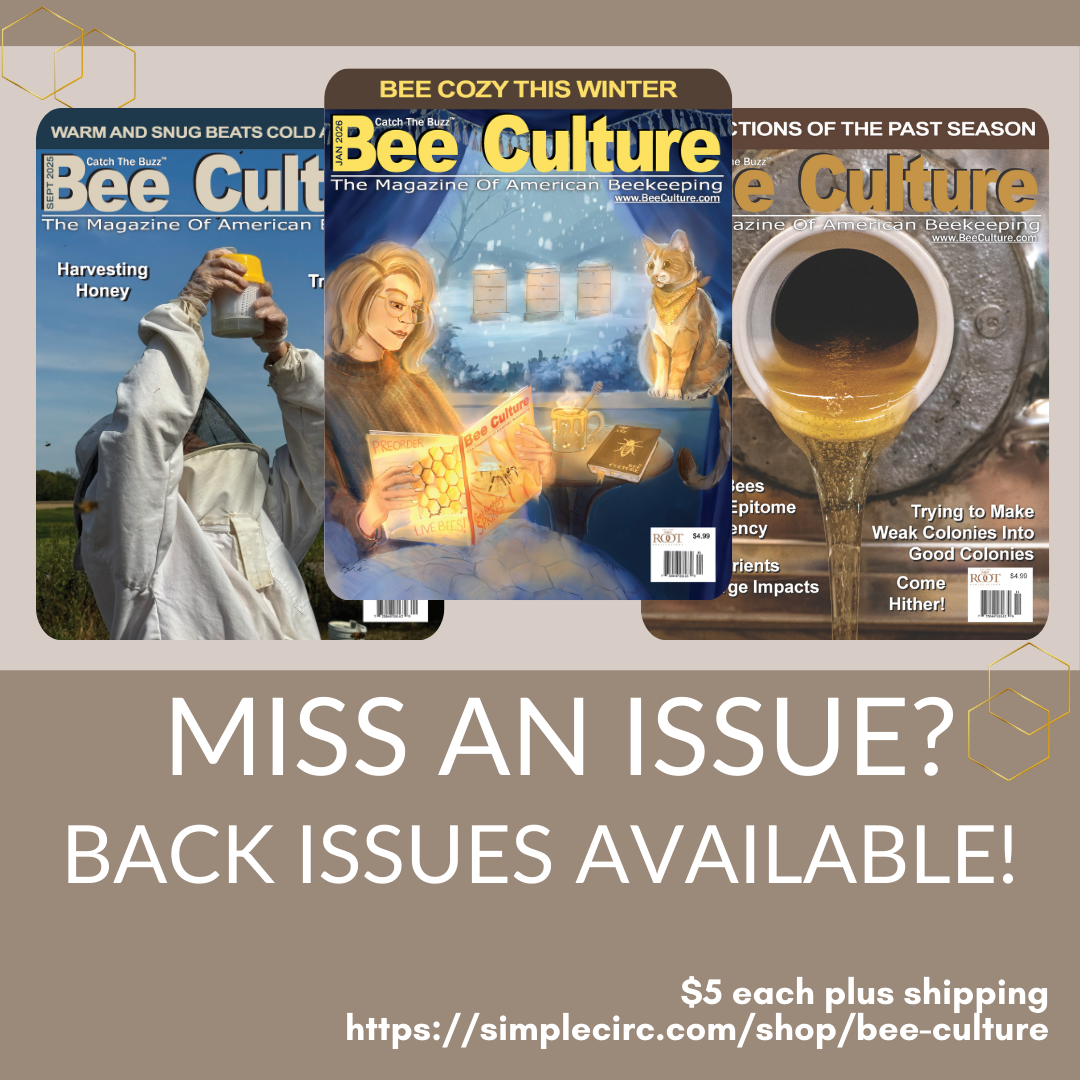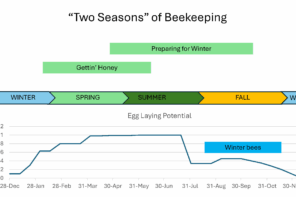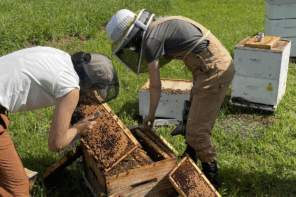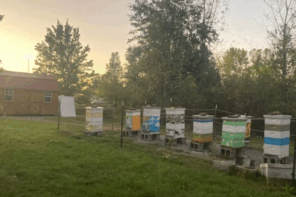By: Jim Metcalf
This article originally appeared in the Winter 2019 issue of BEEKeeping Your First Three Years
Yes, am embarrassed to admit that I was part of a group of old time beekeepers who were no longer welcome at Bee School. Early Spring was the time for our Bee School, a six session series of talks for new and interested beekeepers. New beekeepers, who were learning before they would receive their packages of bees later in the Spring, were an especially nervous, overly serious group. Teaching these newbees was a very serious task as their nervousness interfered with their listening. They all wanted to keep bees, but they also, did not want to make any mistakes which precipitated a nervous flow of how and why questions. Not sure that they were making a sane decision to keep bees, they always asked us old timers, repeatedly, “Why do you keep bees?” For honey, pollination, mead or for candle wax. Our answers always included all of the above up to the time when one frustrated old beekeeper answered by saying, “I knit so I keep honey bees for their wool. My husband and I shear our bees in the Spring.” She proceeded to show one yellow mitten which she claimed to be the result of this Spring’s shearing. Further, she said that they hoped to produce enough bee wool to knit the second mitten next year. The initial silence ended with a loud wow! which was followed by nervousness dissipating laughter allowing learning for enjoyment and comfort with the speakers. At water cooler chats the next day, we wonder how many newbees warded off their coworker’s criticism with the story that they were keeping honey bees for the wool. The Bee School Director was not pleased for our reason for keeping bees and we were asked to more closely follow the school lesson plans.
I think that the experience which caused us old beekeepers to receive our termination was the night that we were teaching Winter hive preparation. Everyone’s questions focused on what do the bees do in the Winter. Do the bees die? Do they hibernate? Do they fly south and return in the Spring? No; they form a cluster with the queen in the center being heated by the surrounding bees. Blank stares and more questions about the cluster and how they generate heat. More stares and more questions. Finally, the old beekeeper trying to explain a heat generating Winter cluster says, Look, if we all get naked and form a tight group in the center of the room, we will generate heat. His explanation was good, generated much laughter, but not acceptable. Those were our last words before those in charge of Beginners Bee School informed us older beekeepers, that the school would be moving in a different direction requiring much more technical instructors. We did not know what a technical instructor was, but guessed that we did not qualify.
Our years of enjoying beekeeping were filled with learning, teaching and scores of funny experiences which turned into interesting stories to be told and enjoyed in bee school. The old stories would relax the newbees enough to learn beekeeping. We old-timers were able to use our experiences to teach about the fun and wonder of keeping bees. Although we now were not technical enough to teach in bee school, we could welcome these newbees into the fellowship of beekeepers through our monthly club meetings where we shared experiences which only beekeepers would understand.
One of the first experiences was to allow the new beekeepers to demonstrate their skills to their family and friends. We told the new beekeepers that, after you set up your new hive in the Spring, observe the entrance. You will notice that the bees will enter on one side and exit on the other side, but if you really want to impress your friends and family tack up Enter and Exit signs in appropriate locations above the entrance. People will be amazed at your ability to train honey bees.
We “old timers” enjoyed beekeeping and each other so much that practical jokes and stories became common place and expected. Once a month throughout the Summer we met at each other’s beeyards to teach through hive openings. At one opening the beekeeper prepositioned an empty hive among her live hives. She selected this hive to be opened for examination while all of us gathered closely around to observe the frames of bees. Unexpectedly, her first move was to loudly bang on the empty hive with a wooden mallet saying that it is always important to knock the bees off the frames for easier observation. However, no one heard the explanation because as soon as the banging began everyone ran for their cars to escape the expected angry stinging swarm. We remember her laughter as we sheepishly exited our vehicles to discover that we had been duped by an empty hive.
Everyone who would host a hive opening that Summer had to get creative to top the hive banging experience. The next month a nice old beekeeper and his wife greeted us at their farm and bee yard for another hive opening. They were such a nice old couple that no one expected any practical jokes. One of those “I know everything about bees” guys was selected to open the hive and instruct the rest of us on the workings of the hive. He was shown a two deep and one honey super hive which he proceeded to open rapidly. As he grabbed the honey super off the hive all ten frames fell out of the bottom of the box all over his feet. The nice little old couple began elbowing each other leading us all in laughter. It seems that they had built the box with upside down hand holds so someone in a hurry, not watching what they were doing would not notice that all the frames were bottom side up and with preparation would all fall out the bottom of the box. We think that the lesson learned was to work slow and smart.
The best hive opening that Summer took place at the home of a straight arrow, no nonsense beekeeper who we knew had no sense of humor. After the usual small talk and sharing of Summer experiences we headed to the bee yard for the opening and instruction session. A first year beekeeper asked to open the hive and was given the privilege. He got his smoker going producing huge clouds of white smoke causing much coughing among the observers. As soon as he blew smoke into the hive entrance a piercing beeping sound was heard within the hive. It seems like our no nonsense host had mounted a home smoke detector within the hive causing a new unexpected funny experience along with a lesson of why create huge clouds of smoke when a little will do.
During the Winter pot luck supper meetings, great stories would continue. Two very old beekeepers found their way on to the agenda to make a presentation on early Spring queen rearing. The interest was high as we all wanted to learn how to produce queens before the first blooms appear. These two keepers holding a fivegallon glass carboy proceeded to tell us that we could place a virgin queen into the jar along with a dozen drones. If one would raise and lower the jar slowly, the queen would fly and be mated by one or more of the drones. To this day we do not know if we were subjected to an April fools’ presentation or if these two beekeepers invented a new queen rearing technique, but I am sure that a number of five-gallon jars were purchased that Spring although no one spoke of success with carboy queen rearing.
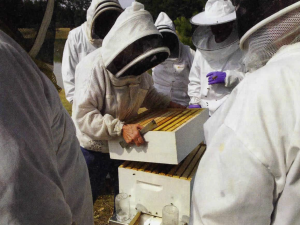
At one other Winter meeting one of the first year beekeepers stood up to offer the rest of us some advice to avoid the strong arm of the law which immediately got our attention. He proceeded to tell us the story about wanting to check his Winter hives for well-being so he struggled through deep snow to the far end of a pasture where his hives were located. Being a medical doctor, he carried with him a stethoscope which he used to listen to each hive to check the cluster’s location and strength. Following the successful hive examination, he was met by the local police at the entrance to the field. It seems as though a passerby reported a crazy person out in the middle to a snow filled field listening to stacks of boxes with a stethoscope. Following this story everyone wanted to buy stethoscopes to go out to their hives in the hope that they could entice passersby to report them to the authorities.
By their second Summer the newbee labels disappeared from most of the first year beekeepers. What we all like about beekeeping besides the hives is the enjoyment and fellowship of fellow keepers of honey bees. Some remain serious; not allowing their sense of humor to show, but others try hard to develop new ways to impress other beekeepers. For example, one young beekeeper showed up at a hive opening dressed in a very colorful flower print Hawaiian shirt which he called a beekeepers’ pollination shirt. Scout bees examined his flowered shirt and returned to their hives. Soon a number of bees were landing on the bright flowers on his shirt. The group was mystified by the activity of the bees. At first the young man explained that he had designed a flowered shirt so beautiful that bees would try to pollinate the flowers. At the end of the meeting he finally admitted that he had added a spot to honey to the center of each flower. We all appreciated his outfoxing us, but would have ordered a shirt before we learned of the joke.
At the next Summer meeting a university entomology professor asked to demonstrate how he inspects a hive for problems and disease. In this yard the hives were placed on stacks of two to three wood pallets. He climbed up on the pallets with confidence, blew a little smoke and lifted off the top deep super. As soon as he took the weight of the 80-pound super in his hands he broke through the pallets. It was then that he learned that the pallets were great nesting places for snakes. In this case a large red and white milk snake came at the bee inspector because it was stepped on by the professor. The shock of falling through the pallets with a heavy super together with the mistake in thinking that the colorful snake was a rattler caused the inspector to jump on top of the hive while throwing the removed super at the snake causing all of us to howl with laughter, but run for our cars with so many bees in the air. A few of us suited up to repair the hive and pallets. The beekeeper who owned the hive said that he knew snakes lived in the pallets because they kept mice and other small animals away from the hives. However, the entomology professor refused to inspect anymore hives unless they were on solid cement blocks without snakes.
We old timers may have been passed over for more technical bee School Instructors, but for many of us the best thing about beekeeping is the fellowship among a group of people who enjoy each other and the experiences that we share. As the years go by fewer and fewer old beekeepers attend club meetings and hive openings. This is our loss as their stories and practical jokes always caused much laughter, but even more importantly these old time beekeepers passed along important lessons, a comfort in handling the bees and a sincere enjoyment of beekeeping.




